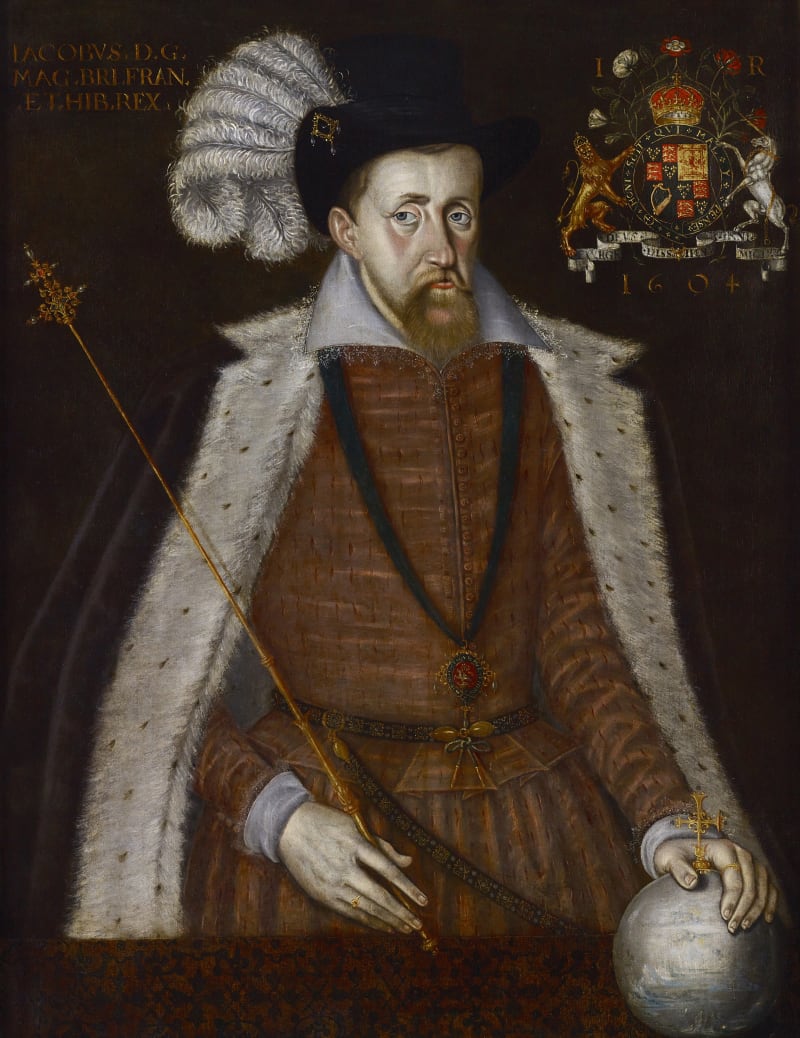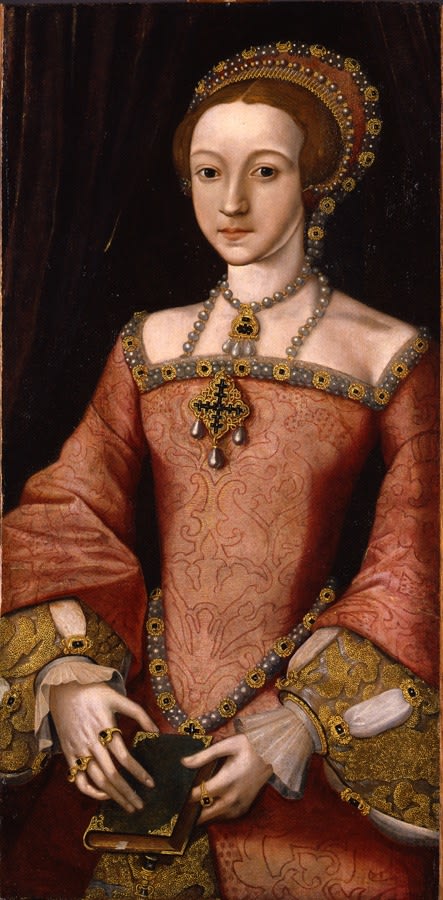This painting of the young Queen dating to c.1558 is ‘undoubtedly the earliest portrait of the Queen after her accession’1. It is remarkable in the simplicity of its conception, and offers a surprising and refreshing alternative glimpse of Elizabeth the woman in comparison with the more familiar, later portraits, in which the individual is obscured and then entirely overwhelmed in a profusion of emblematic and allegorical representation. In the assessment of Malcolm Rogers ‘it is by far the most ambitious and the only one at three-quarter length and showing her hands (which were much admired by contemporaries).’2 Rogers also notes the painting’s superb condition, and the ‘considerable refinement and delicacy of touch’3 evident in the execution. Sir Roy Strong agrees that ‘this very early image, the Clopton portrait is by far the largest and most complete.’4
Survivals of this early pattern are rare, and the present example is unique in showing the Queen at three-quarter length. The few other...
This painting of the young Queen dating to c.1558 is ‘undoubtedly the earliest portrait of the Queen after her accession’1. It is remarkable in the simplicity of its conception, and offers a surprising and refreshing alternative glimpse of Elizabeth the woman in comparison with the more familiar, later portraits, in which the individual is obscured and then entirely overwhelmed in a profusion of emblematic and allegorical representation. In the assessment of Malcolm Rogers ‘it is by far the most ambitious and the only one at three-quarter length and showing her hands (which were much admired by contemporaries).’2 Rogers also notes the painting’s superb condition, and the ‘considerable refinement and delicacy of touch’3 evident in the execution. Sir Roy Strong agrees that ‘this very early image, the Clopton portrait is by far the largest and most complete.’4
Survivals of this early pattern are rare, and the present example is unique in showing the Queen at three-quarter length. The few other examples, such as that in the collection of the National Portrait Gallery (NPG 4449), formerly at Northwick Park, show the Queen only at bust-length, and are noticeably more wooden in execution. NPG 4449 reduces the composition to a mere head emerging from an ermine collar, and the Queen’s jewellery is treated in a cursory and schematic manner. Considering the NPG portrait it is easy to understand why Elizabeth was forced in 1563 to issue a proclamation banning the further reproduction of her portrait until she had sat for a new model.
The authority of the Clopton portrait is apparent in the meticulous painting of the Queen’s ruff and cuffs, and the highly realistic depiction of her ermine collar. The painting of the face is in the tradition of English mid-sixteenth portraiture with its hard, delicate rendition of eyes, nose and mouth, but the painter has modelled the face to suggest real presence and animation which elevate it above the ranks of the increasingly mechanical and mask-like reproductions. Perhaps the most telling detail, however, which confirms the status of this portrait is the drawing of the large, square-cut jewel that the Queen wears from the double chain around her neck. This is simplified to its bare outline in NPG 4449, and the male and female figures that flank the cartouche have been misunderstood as mannerist curlicues. Throughout her reign, as her portraiture amply demonstrates, Queen Elizabeth’s jewellery was a vastly important facet of her magnificence. Numerous pieces of emblematic jewellery were worn by her, and given and exchanged between her and favourite courtiers, some of which, such as ‘The Ship Jewel’ in the Victoria and Albert Museum, survive to give a taste of their luxury. Little survives, as it was swiftly dispersed by her successors, James I and Charles I. The Clopton portrait is an important record of what must have been one of the Queen’s favourite and oldest jewels, the jewel known as ‘The Mirror of France’ which had belonged to King Henry VIII her father. The large pendant is represented so exactly that it can be recognised in at least three later portraits. She wears it from a chain around her neck in an anonymous panel portrait dated by Strong to c.1568 and again in the later Portrait of Queen Elizabeth in Robes of State c.1585 – 90 (collection of Lord Tollemache, Helmingham Hall). It is also recognisable in the famous ‘Sieve portrait’ (Marquess of Salisbury, Hatfield House).
This portrait was in the collection of the Rev F. H. Hodgson at Clopton House in Warwickshire, where it hung with portraits of the Clopton family, remaining after the sale of Clopton House in 1930 with Hodgson’s heirs until the 1980s. The Cloptons had been a family of considerable importance in Stratford on Avon, and members of the family had been benefactors and chief citizens of the town since the early middle ages. During the reign of Elizabeth they lived both at Clopton House just outside the town and at New Place, a large gabled building set around three courtyards next to the Guild Chapel built by their ancestor Sir Hugh Clopton, Lord Mayor of London in 1492. This house, where the present portrait may well have hung during their occupancy, was sold to another of Stratford’s prominent citizens in 1597, William Shakespeare, for the considerable sum of £120. Shakespeare would have had frequent dealings with the Cloptons, since he and they were the town’s richest inhabitants and chief landowners in the country nearby. The history of the Cloptons even influenced one of Shakespeare’s plays, since the story of Charlotte Clopton who was hastily interred alive in the Clopton vault during a sixteenth century outbreak of plague, is considered to be the source of the death of Juliet in Romeo and Juliet.
1. Private correspondence with Malcolm Rogers, then Deputy Director of the National Portrait Gallery London August 3rd 1992
2. ibid.
3. ibid.
4. Private correspondence with Sir Roy Strong July 27th 1991.






